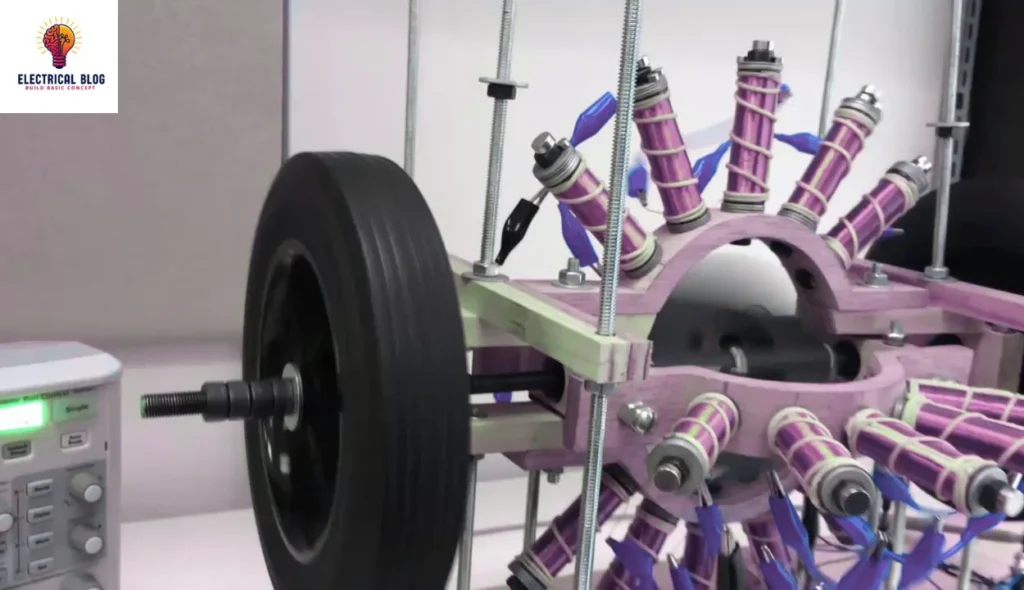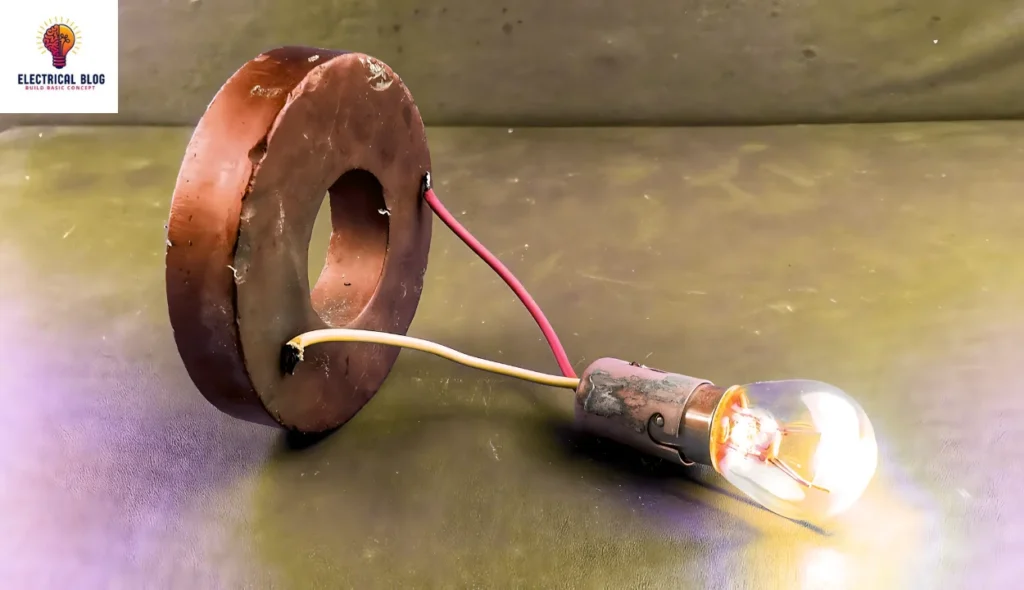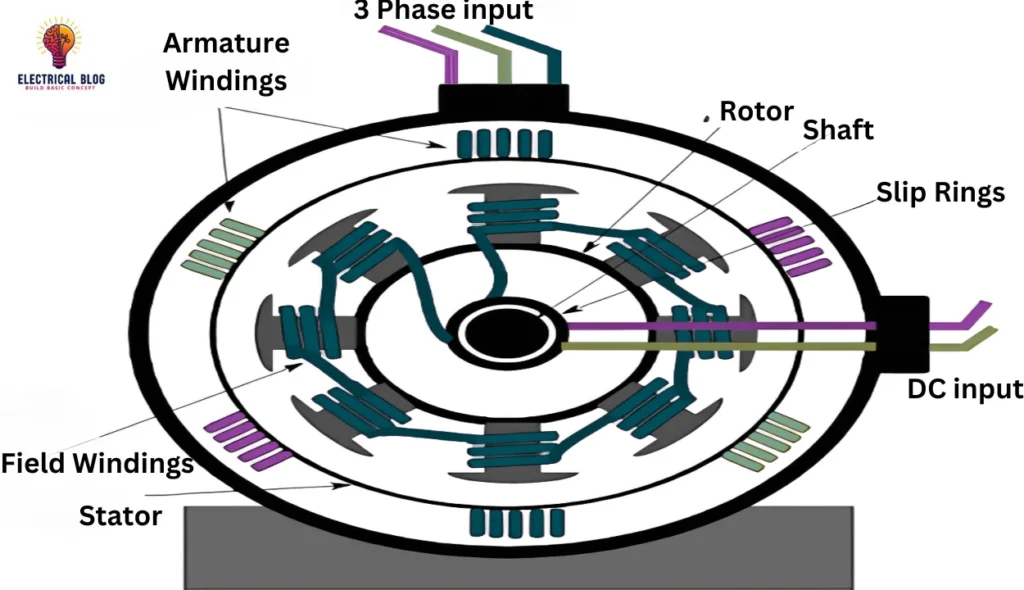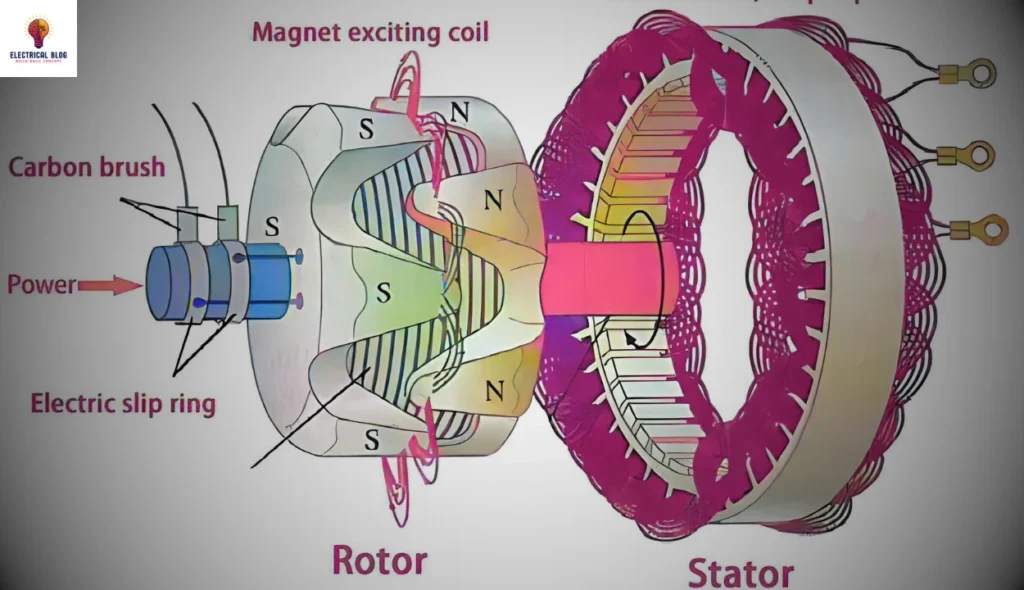What is an electromagnetic generator?
An electromagnetic generator converts mechanical energy into electric current using magnetic fields. Through rotation, a coil moves in a perpendicular path to the magnetic field, creating a sine wave that alternates between positive and negative values. This alternating current (AC) is later converted to DC for charging batteries or powering devices.
The generation process follows Faraday’s law, where the flux change across an area induces voltage. Devices like dynamos, alternators, and tidal turbines rely on this induction principle. Systems use turbines powered by steam, gas, or combustion engines to maintain a constant rotation pattern, ensuring a stable output. Photovoltaic cells or electrochemical methods can also provide low voltage for smaller applications. You can also read Synchronous Generators.
Electromagnetic Generator diagram

Electromagnetic Generator Configuration and Efficiency
An electromagnetic generator uses a coil that rotates along a shaft inside a magnetic field, producing a sine wave. This rotation causes a phase shift that influences voltage and amperage levels. In single-phase systems, the wave reaches zero at 180°, while three-phase designs achieve a higher average power output due to separated degrees in each phase.
For better efficiency, some designs use permanent magnets and static parts to reduce heat and loss. A well-planned configuration balances amplitude and frequency, making it comparable to standard grid sources. In my experience, understanding the illustration of individual parts, like the electromagnet, improves generator design and overall performance.
Key Factors Affecting Electromagnetic Generator Output
The number of coils and loops in the generator directly affects the magnetic field strength and output power. More coils increase the energy produced in each rotation.
The speed of rotations is crucial; common frequencies like 50 Hz or 60 Hz are achieved by controlling the time and units of each spin.
A larger area covered by the coil enhances the interaction with the magnetic field, boosting power output.
Ensuring that the magnetic strength is optimized helps maintain stable voltage for reliable power delivery to the grid.

Key Components of an Electromagnetic Generator
Rotor
Stator
Shaft
Commutator (DC generators)
Slip ring (AC generators)
Brushes
Field
An alternator uses magnets or electromagnets to create a magnetic field that interacts with windings. The rotor, often mounted on a shaft, spins inside this field to generate electric current.
Armature
The stator holds the armature, where the current is provided as output. While permanent magnets are used in simpler setups like a dynamo, larger systems rely on powered electromagnets for improved performance.
Commutator
A commutator is a key component in an electromagnetic generator that converts AC into DC. It uses pairs of segments mounted on the shaft to manage rotation and maintain an unchanged direction for direct current. The commutator works by transferring power from the armature to the external circuit.
During rotation, the windings’ position shifts, and the commutator adjusts the polarity of the magnetic field. This rectifying action ensures the DC generated flows steadily without reversing. Brushes in contact with the bars allow continuous power flow as the rotor makes a full turn.
In my experience, ensuring proper alignment between brushes and commutator segments is vital. Poor alignment may cause changes in relation to the commutator and generator, affecting efficiency. This precise design provides stable DC output, making it essential for dynamo-type systems.
Slip Ring
A slip ring is used in generators and alternators to transfer alternating current (AC) smoothly. Unlike a commutator, it has segmented rings that maintain high voltage levels while ensuring current is safely picked up by the brushes. This design helps avoid disruptions and efficiently produces AC without converting it to DC.

Electrical Power Generation in Electromagnetic Generators
Synchronous AC Generator
A synchronous AC generator produces alternating current by rotating a rotor inside a magnetic field. The rotor is often mounted on a turbine shaft, with its speed determined by the frequency required. The stator holds the armature, where the sine wave voltage is induced as the rotor spins.
In my experience, brushes and slip rings are essential for transferring DC to the rotor, ensuring a steady magnetizing current. The amplitude of the generated power is proportional to the rotational speed and positioning of the windings. Designs like cylindrical and turbo constructions are common for handling high RPMs and precise phase control.
Static Field Synchronous AC Generator
A Static Field Synchronous AC Generator uses permanent magnets or a magnetized field to create current. Unlike traditional generators, its armature is mounted on the shaft, while the stator holds the winding. This design eliminates sliding parts like brushes and collectors, improving durability.
In my experience, this type of generator is ideal for smaller systems with KVA ratings under 4 or 5. The poles are often designed to point outwards, enhancing the three-phase current flow. With no need for slip rings, these systems efficiently handle stable AC output without frequent maintenance.
Asynchronous AC Generator
An asynchronous generator is commonly used in small plants like wind or hydro systems. It relies on rotating turbines to spin a metal rotor inside the stator, where electric current is induced. The generator must be connected to an external source to start producing electricity.
The construction often includes copper or aluminium rods in the rotor, positioned to interact with the magnetic field. Unlike a synchronous system, its speed may vary slightly but still delivers stable power to the grid. Efficient utilization of each component helps ensure power output does not exceed safe poles and control limits.
Conclusion
The Electromagnetic Generator is key to today’s power generation. It uses different designs, such as synchronous and asynchronous systems. By understanding components such as the commutator, slip rings, and rotor, we can enhance efficiency and ensure stable electricity delivery. Efficient utilization of resources like turbines, magnets, and windings is essential for maximizing power output in both small and large plants.


